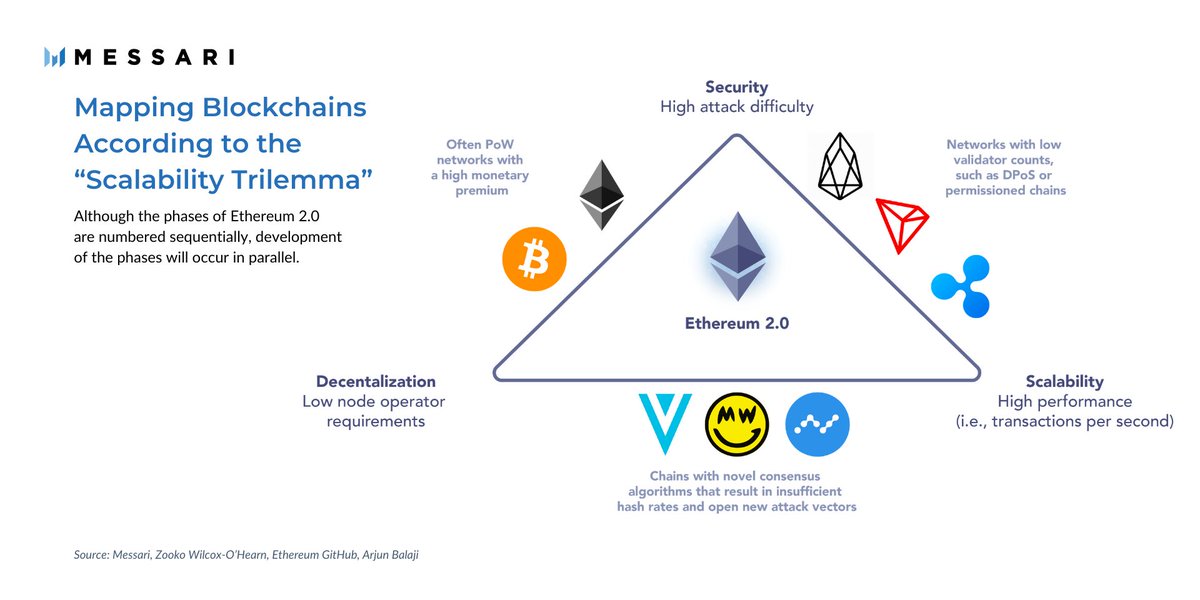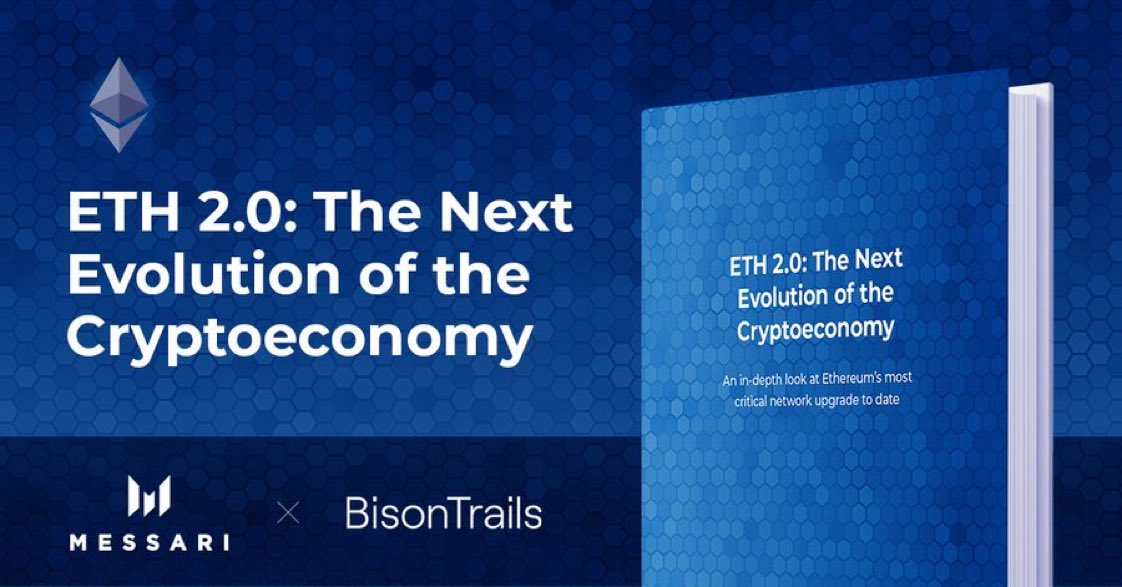Eth2 has 2 core components. The first is Proof of Stake, as introduced this week.
The second is scalability, for which Ethereum will turn to sharding.
While sharding isn’t new, Eth2’s approach will be the most significant attempt at scaling base layer blockchains to date.
1/
The second is scalability, for which Ethereum will turn to sharding.
While sharding isn’t new, Eth2’s approach will be the most significant attempt at scaling base layer blockchains to date.
1/
First, it’s important to understand why scalability is necessary
Most obviously, scalability is essential for user experience (low latency, low fees).
Equally as important, It also helps keep validator costs low.
Most obviously, scalability is essential for user experience (low latency, low fees).
Equally as important, It also helps keep validator costs low.
Without scalability, high infrastructure costs could lead nodes to use cloud computing providers.
And if users get priced out of using Ethereum directly, they’ll turn to centralized intermediaries.
Scalability is ultimately essential for anti-fragility & self-sovereignty.
And if users get priced out of using Ethereum directly, they’ll turn to centralized intermediaries.
Scalability is ultimately essential for anti-fragility & self-sovereignty.
Second, scaling is hard.
There's a finicky relationship between decentralization, security, & scalability, that prevents chains from featuring all 3 properties, often called the Scalability Trilemma.
Solving this trilemma has been hailed as the holy grail of blockchains.
There's a finicky relationship between decentralization, security, & scalability, that prevents chains from featuring all 3 properties, often called the Scalability Trilemma.
Solving this trilemma has been hailed as the holy grail of blockchains.
Sharding has the potential to bridge the gap between these 3 properties.
At a high level, splitting a blockchain into smaller pieces called shards, which run in parallel and ultimately link back to each other. Each shard has a subset of nodes processing blocks of transactions.
At a high level, splitting a blockchain into smaller pieces called shards, which run in parallel and ultimately link back to each other. Each shard has a subset of nodes processing blocks of transactions.
In Phase 1, Eth2 will have 64 of these shards, theoretically increasing throughput capacity roughly 64x compared to what’s currently possible.
Since each shard will have a dynamic subset of nodes processing blocks, nodes won't have to store and process every transaction.
Since each shard will have a dynamic subset of nodes processing blocks, nodes won't have to store and process every transaction.
This preserves decentralization because it lowers node infrastructure costs.
And sharding can preserve security since it doesn’t fundamentally alter consensus.
Random sampling of validators and security deposits used in Eth2’s PoS consensus naturally extend to securing shards.
And sharding can preserve security since it doesn’t fundamentally alter consensus.
Random sampling of validators and security deposits used in Eth2’s PoS consensus naturally extend to securing shards.
So why is Eth2’s scalability approach the most significant attempt at scaling base layer blockchains to date?
Three reasons:
 Size of the validator set
Size of the validator set
 Scale of signature aggregation
Scale of signature aggregation
 Volume of ongoing activity
Volume of ongoing activity
Three reasons:
 Size of the validator set
Size of the validator set Scale of signature aggregation
Scale of signature aggregation Volume of ongoing activity
Volume of ongoing activity
Validator set
Eth2 already has the largest validator set of any other PoS network, and this will remain true when Phase 1 arrives
It also doesn’t have a theoretical limit. Most other networks run into performance issues beyond a certain validator set threshold.
Eth2 already has the largest validator set of any other PoS network, and this will remain true when Phase 1 arrives
It also doesn’t have a theoretical limit. Most other networks run into performance issues beyond a certain validator set threshold.
Signature aggregation
It ties into the above, but the reason Eth2 doesn’t have a validator limit is due to its use of BLS.
Many validators lead to many signatures on blocks, which can cause overhead issues.
BLS allows Eth2 to maintain decentralization and throughput capacity.
It ties into the above, but the reason Eth2 doesn’t have a validator limit is due to its use of BLS.
Many validators lead to many signatures on blocks, which can cause overhead issues.
BLS allows Eth2 to maintain decentralization and throughput capacity.
Ongoing activity
While other networks have implemented a form of sharding, none have the level of on-chain activity that’s seen on Ethereum.
Until they do, it’s hard to say if anyone has solved the Scalability Trilemma since these chains don’t have a need for scalability yet.
While other networks have implemented a form of sharding, none have the level of on-chain activity that’s seen on Ethereum.
Until they do, it’s hard to say if anyone has solved the Scalability Trilemma since these chains don’t have a need for scalability yet.
There are some tradeoffs involved with sharding.
1) Sharding is complex, which is why it has taken many years to design and may not launch for at least another year.
2) Cross-shard transactions must be asynchronous, meaning apps on different shards won’t be composable.
1) Sharding is complex, which is why it has taken many years to design and may not launch for at least another year.
2) Cross-shard transactions must be asynchronous, meaning apps on different shards won’t be composable.
Some have speculated that the overhead involved in processing cross-shard transactions might be more trouble than sharding is worth.
But there are potential solutions that could improve cross-chain interactions, like 3rd-party liquidity networks (THORChain) or contract yanking.
But there are potential solutions that could improve cross-chain interactions, like 3rd-party liquidity networks (THORChain) or contract yanking.
Only time will tell if these efforts materialize into effective cross-shard solutions.
Even with these concerns, sharding provides enough scaling benefits that fit Eth2’s design principles, leading Ethereum researchers to deem it worth any tradeoffs. https://twitter.com/RyanWatkins_/status/1333588739277414401
Even with these concerns, sharding provides enough scaling benefits that fit Eth2’s design principles, leading Ethereum researchers to deem it worth any tradeoffs. https://twitter.com/RyanWatkins_/status/1333588739277414401
Since sharding won’t arrive until Phase 1, which could be over a year away, what is Ethereum’s near-term scalability solution?
The short answer is layer-2 solutions, which I’ll explore in a later thread (coming soon).
The short answer is layer-2 solutions, which I’ll explore in a later thread (coming soon).
The key takeaway is that sharding + layer-2 solutions could give Ethereum a throughput capacity of over 100k tps, a massive upgrade compared to its current double-digit capacity. https://ethereum-magicians.org/t/a-rollup-centric-ethereum-roadmap/4698
After years of research, it looks like scalability without sacrificing decentralization is possible, and Ethereum has bet that sharding is key to achieving it.
There’s much more on Eth2's sharding approach in our Eth2 report, which you can check out here: http://bit.ly/2KXLKcj
There’s much more on Eth2's sharding approach in our Eth2 report, which you can check out here: http://bit.ly/2KXLKcj

 Read on Twitter
Read on Twitter




